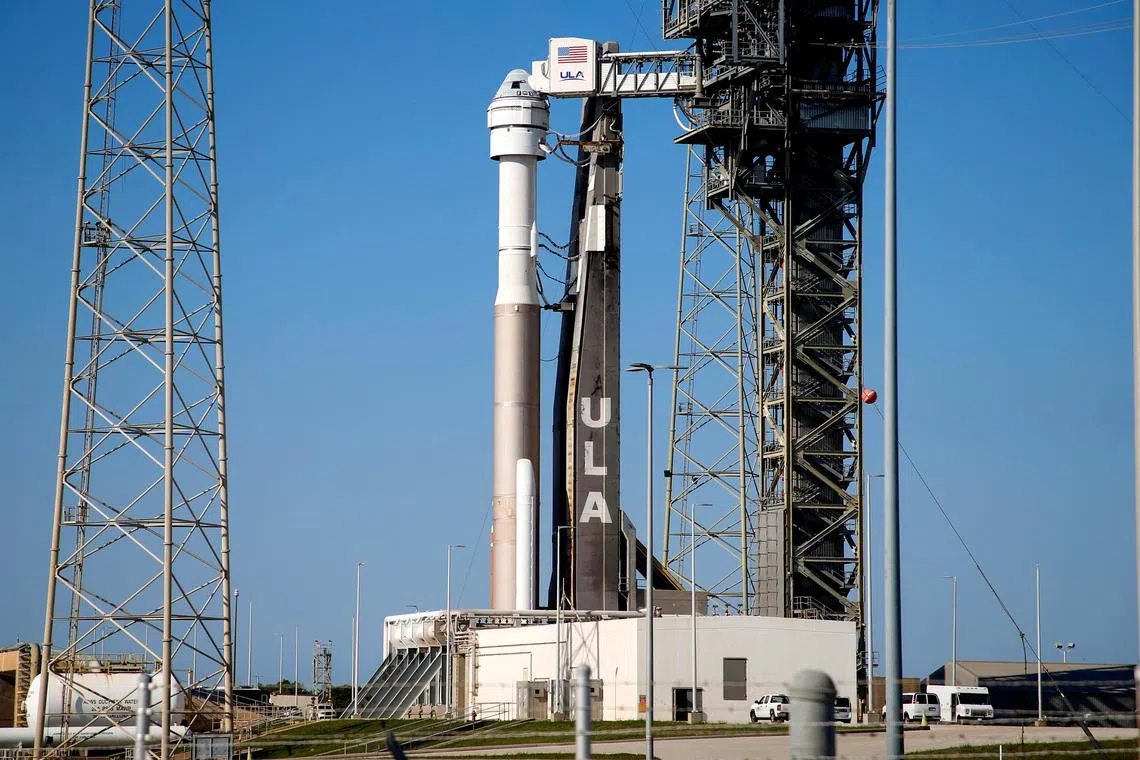Boeing's Starliner capsule set for launch of first crewed space flight
Sign up now: Get ST's newsletters delivered to your inbox

A United Launch Alliance Atlas V rocket being prepared for another launch attempt in Cape Canaveral, Florida, on May 31.
PHOTO: REUTERS
Follow topic:
CAPE CANAVERAL, Florida – Boeing's new Starliner astronaut capsule is poised for launch on June 1 in a much-delayed first crewed test flight, a milestone in the beleaguered aerospace giant's aim to compete with Mr Elon Musk's SpaceX in the astronaut launch business.
The CST-100 Starliner with two astronauts aboard is due for lift-off at 12.25pm local time (12.25am on June 2 Singapore time) from Nasa's Kennedy Space Centre in Florida, strapped to an Atlas V rocket from Boeing-Lockheed Martin joint venture United Launch Alliance (ULA).
A May 6 countdown was halted
"This is a test flight, we know we're going to learn some things," Boeing's commercial crew vice-president, Mr Mark Nappi, said during a news conference on May 31.
The gumdrop-shaped capsule and its crew are bound for the International Space Station (ISS), two years after the Starliner completed its first test voyage to the orbital laboratory without astronauts aboard.
Boeing, with its commercial airplane operations staggering from a series of crises involving its 737 MAX jetliners, needs a win in space for its Starliner venture, already several years behind schedule and more than US$1.5 billion (S$2 billion) over budget.
The company is a long-time Nasa contractor that has built modules for the decades-old ISS and rockets designed to loft astronauts towards the Moon.
But never before has it built its own operational spacecraft, a feat complicated by years of software issues, technical glitches and management shake-ups on the Starliner program.
While Boeing has struggled, SpaceX has become a dependable taxi to orbit for the US space agency, which is backing a new generation of privately built spacecraft for flying astronauts to low-Earth orbit and – under its ambitious Artemis programme – on to the Moon and eventually Mars.
Starliner will compete head-to-head with SpaceX's Crew Dragon capsule, which since 2020 has been Nasa's only vehicle for sending ISS crew members to orbit from US soil.
Nasa has long sought two US rides to the station, in addition to the joint astronaut flights it conducts with Russia's Soyuz rocket.
The inaugural crew for the seven-seat Starliner includes two veteran Nasa astronauts: Mr Barry "Butch" Wilmore, 61, a retired US Navy captain and fighter pilot, and Ms Sunita "Suni" Williams, 58, a former Navy helicopter test pilot with experience flying more than 30 different aircraft.
They have spent a combined 500 days in space over the course of two ISS missions each. Mr Wilmore is the designated commander for Saturday's flight, with Ms Williams in the pilot seat.
Although Starliner is designed to fly autonomously, the crew can assume control of the spacecraft if necessary.
The test flight calls for Mr Wilmore and Ms Williams to practice manoeuvring the vehicle manually en route to the space station, where it will remain docked for at least eight days before returning to Earth.
If Boeing delays its June 1 launch attempt, the company has back-up launch opportunities on June 2, June 5 and June 6.
And if it cannot make those days, some items on Starliner and the rocket would need to be replaced or replenished, spurring delays of weeks or potentially months given conflicting schedules with other ULA missions and the ISS.
The flight on June 1 marks the first crewed Atlas voyage to space since earlier versions of the storied rocket dynasty first sent US astronauts, including Mr John Glenn, to orbit during Nasa's Mercury program in the 1960s.
If all goes as planned, the capsule will arrive at the space station after a flight of about 26 hours and dock with the orbiting research outpost some 400km above Earth.
Mr Wilmore and Ms Williams are expected to remain at the space station for about a week before riding the capsule back to Earth for a parachute and airbag-assisted landing in the US Desert South-west – a first for a crewed Nasa mission. REUTERS

